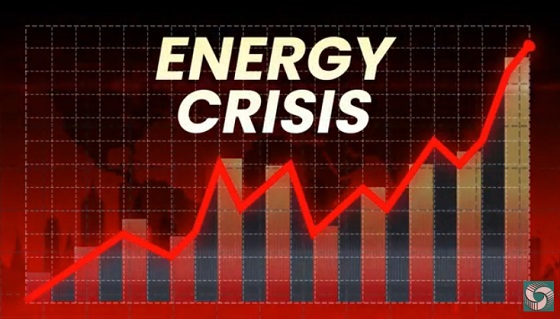Energy
Climate Change Movement Goes To Court — Will Judges Ban Fossil Fuels?

 From the Daily Caller News Foundation
From the Daily Caller News Foundation
Things are not going well at all for the global warming crusaders. Despite hundreds of billions of tax dollars spent on green energy over the past decade, the world and America used more fossil fuels than ever before in history last year.
The electric vehicle movement is stalled out, solar and wind power are both still fringe forms of energy, and the green candidates got crushed in recent elections in Europe because voters are sick of the higher prices associated with green policies.
So, having struck out with consumers, businesses and at the ballot box, the greens now are moving on to the courts. The climate-change industrial complex has now joined forces with trial lawyers to advance their war on fossil fuels.
One of the more absurd lawsuits happened in Hawaii.
There, a group of 13 teenagers — honest, I’m not making this up — sued Hawaii’s government over its use of fossil fuels. Environmental law firms Our Children’s Trust and Earthjustice claim that Hawaii’s natural resources are imperiled by CO2 emissions. Even if that were true, shouldn’t they be suing China?
The settlement will require the state to eliminate fossil fuels from its transportation system by 2045, and also formally recognizes the right to file future lawsuits against other parties.
Democratic Gov. Josh Green even stood next to the young plaintiffs as he read a statement claiming, “This settlement informs how we as a state can best move forward to achieve life-sustaining goals.”
There is so much that is wrong about this decision. How did a bunch of teenagers possibly have standing to sue? What possible harm have they suffered from fossil fuels?
The irony is that this island paradise in the Pacific — whose primary industry is tourism — is going to collapse without fossil fuels. With no jets and cruise ships allowed, will tourists and business travelers have to arrive by sailboat?
But this new technique of using lawsuits to advance the anti-fossil fuels movement has spread to other states. Last August, a judge ruled that GOP-dominated Montana violated its constitution when it approved fossil fuel projects without taking climate change into account.
After recent flooding in Vermont, green activists sued the state for not abolishing fossil fuels.
Massachusetts is suing Exxon Mobil for adverse weather conditions.
There are now 32 cases filed by state attorneys general, cities, counties and tribal nations against companies including Exxon Mobil, BP and Shell. The lawsuits claim that the industry tried to undermine scientific consensus about the crisis.
Here’s what’s so frightening about these sham lawsuits from trial lawyers who hope to turn oil companies into cash cows similar to the tobacco lawsuits 20 years ago: The end game of lawsuits against states and oil and gas companies for using or producing energy because of alleged damage to the environment could bring about abolition of fossil fuels through the back door of the nation’s courthouses.
But what none of these judges or litigators take into account is the catastrophic economic effects of not using fossil fuels. As an example, the Left wants to abolish air conditioning, which requires electricity, which mostly comes from fossil fuels. But air conditioning saves tens of thousands of lives a year. What about the millions of jobs that would be wiped out with no fossil fuels? How many thousands of Americans would die in hospitals, or assisted living centers, or day care centers, or schools if the lights go out with no fossil fuel power plants?
Fossil fuels have saved millions more lives over the last century than they take. They make Americans much richer and safer and happier and healthier and more mobile. Meanwhile, there is no evidence backing up the absurd claim by teenagers that if Hawaii stopped using fossil fuels, the state’s weather conditions would improve.
Will judges take that into consideration when they try to rob Exxon and coal companies of their profits for the sin of making life on earth much better?
Stephen Moore is a visiting fellow at the Heritage Foundation and a senior economic advisor to Donald Trump. His latest book is: “Govzilla: How the Relentless Growth of Government Is Devouring Our Economy.”
The views and opinions expressed in this commentary are those of the author and do not reflect the official position of the Daily Caller News Foundation.
(Featured Image Media Credit: Screen Capture/Supreme Court of the United States)
Energy
Federal Clean Power Plan Risks Blackouts And Higher Bills

From the Frontier Centre for Public Policy
Ottawa’s Clean Electricity Regulations could derail Canada’s energy future. Here’s what we need to do
The federal government’s push to make Canada’s electricity system net-zero is running straight into reality—and it’s not pretty.
Through the Clean Electricity Regulations (CER), the government wants all provinces to eliminate greenhouse gas emissions from electricity generation by 2035. It is an ambitious goal, but one that ignores a basic fact: demand for electricity is exploding, and provinces are struggling to keep up.
New technologies like artificial intelligence are supercharging this demand. AI systems, including tools such as ChatGPT, rely on massive data centres—huge warehouses of computer servers that need constant cooling and enormous amounts of electricity to function. According to a recent Royal Bank of Canada report, if all proposed data centre projects in Canada move ahead, they would consume 14 per cent of the country’s entire electricity supply by 2030. That is roughly the same as projections in the United States, where data centres are expected to use up to 15 per cent of the national total.
This is a serious problem. Provinces such as Alberta and Saskatchewan have already raised the alarm, arguing that the federal regulations overstep Ottawa’s constitutional authority. Energy supply, like natural resources, has traditionally been under provincial control. Alberta and Ontario operate their own electricity markets to attract investment and ensure reliability. Federal regulations threaten to undermine these efforts, adding risk and driving up costs.
The situation is already tense. Alberta, for example, issued multiple grid alerts in 2024 due to shortages and market disruptions. The province is now looking at “behind-the-fence” power solutions, encouraging data centres to generate their own electricity to guarantee stability.
Canada was not always in this bind. For decades, we enjoyed an abundance of clean, affordable hydroelectric power. Provinces like Quebec, British Columbia, Manitoba and Newfoundland and Labrador built massive hydro projects starting in the 1960s, creating cheap power and even surpluses to export to U.S. markets. In 2022, for example, B.C. sent 74 per cent of its exported power to the U.S., while Quebec sent 63 per cent and Ontario an impressive 81 per cent, generating billions in revenue.
But that era is coming to an end. Most of the best sites for hydro dams have already been developed. New projects would require expensive, long-distance transmission lines to bring power from remote areas to the cities that need it. On top of that, growing environmental concerns make new dam construction an uphill battle.
The truth is, there is no quick fix. A 2025 study by the Fraser Institute paints a grim picture: to meet future electricity demand solely with solar power would require 1,680 years of construction. Wind power? About 1,150 years. Even hydro would take close to a millennium. Even if we combined these sources, we are still looking at more than 1,000 years to build enough capacity.
Meanwhile, federal projections estimate that Canada’s electricity demand will double by 2050.
Without significant policy changes, Canadians could soon face the worst of both worlds: soaring electricity bills and the threat of power shortages. Our economy could also suffer as companies and data centres look to other jurisdictions with more reliable power supplies.
So what should Canada do? Here are three practical steps:
- Scrap the Clean Electricity Regulations. Provinces like Alberta and Saskatchewan are already committed to reaching net-zero by 2050. Federal interference only creates unnecessary political battles and delays investments.
- Fast-track approvals for new interprovincial transmission lines. Today, building a new transmission line can take more than a decade. Speeding up this process would help provinces share power and avoid costly overbuilding of generation capacity.
- Launch a major low-interest loan program to build new power infrastructure. We need to dramatically expand our generation and transmission systems, including natural gas-fired plants, to meet future demand.
Canadians deserve a reliable, affordable and clean energy future. But we will not get there by ignoring the realities of rising demand and provincial responsibilities. It is time for the federal government to listen to the provinces, embrace practical solutions and avoid an avoidable crisis.
Otherwise, we are on track for blackouts, higher bills and missed economic opportunities.
Maureen McCall is an energy business analyst and Fellow at the Frontier Center for Public Policy. She writes on energy issues for EnergyNow and the BOE Report. She has 20 years of experience as a business analyst for national and international energy companies in Canada.
Economy
The Net-Zero Dream Is Unravelling And The Consequences Are Global

From the Frontier Centre for Public Policy
The grand net-zero vision is fading as financial giants withdraw from global climate alliances
In recent years, governments and Financial institutions worldwide have committed to the goal of “net zero”—cutting greenhouse gas emissions to as close to zero as possible by 2050. One of the most prominent initiatives, the Glasgow Financial Alliance for Net Zero (GFANZ), sought to mobilize trillions of dollars by shifting investment away from fossil fuels and toward green energy projects.
The idea was simple in principle: make climate action a core part of financial decision-making worldwide.
The vision of a net-zero future, once championed as an inevitable path to global prosperity and environmental sustainability, is faltering. What began as an ambitious effort to embed climate goals into the flow of international capital is now encountering hard economic and political realities.
By redefining financial risk to include climate considerations, GFANZ aimed to steer financial institutions toward supporting a large-scale energy transition.
Banks and investors were encouraged to treat climate-related risks—such as the future decline of fossil fuels—as central to their financial strategies.
But the practical challenges of this approach have become increasingly clear.
Many of the green energy projects promoted under the net-zero banner have proven financially precarious without substantial government subsidies. Wind and solar technologies often rely on public funding and incentives to stay competitive. Energy storage and infrastructure upgrades, critical to supporting renewable energy, have also required massive financial support from taxpayers.
At the same time, institutions that initially embraced net-zero commitments are now facing soaring compliance costs, legal uncertainties and growing political resistance, particularly in major economies.
Major banks such as JPMorgan Chase, Citigroup and Goldman Sachs have withdrawn from GFANZ, citing concerns over operational risks and conflicting fuduciary duties. Their departure marks a signifcant blow to the alliance and signals a broader reassessment of climate finance strategies.
For many institutions, the initial hope that governments and markets would align smoothly around net-zero targets has given way to concerns over financial instability and competitive disadvantage. But that optimism has faded.
What once appeared to be a globally co-ordinated movement is fracturing. The early momentum behind net-zero policies was fuelled by optimism that government incentives and public support would ease the transition. But as energy prices climb and affordability concerns grow, public opinion has become noticeably more cautious.
Consumers facing higher heating bills and fuel costs are beginning to question the personal price of aggressive climate action.
Voters are increasingly asking whether these policies are delivering tangible benefits to their daily lives. They see rising costs in transportation, food production and home energy use and are wondering whether the promised green transition is worth the economic strain.
This moment of reckoning offers a crucial lesson: while environmental goals remain important, they must be pursued in balance with economic realities and the need for reliable energy supplies. A durable transition requires market-based solutions, technological innovation and policies that respect the complex needs of modern economies.
Climate progress will not succeed if it comes at the expense of basic affordability and economic stability.
Rather than abandoning climate objectives altogether, many countries and industries are recalibrating, moving away from rigid frameworks in favour of more pragmatic, adaptable strategies. Flexibility is becoming essential as governments seek to maintain public support while still advancing long term environmental goals.
The unwinding of GFANZ underscores the risks of over-centralized approaches to climate policy. Ambitious global visions must be grounded in reality, or they risk becoming liabilities rather than solutions. Co-ordinated international action remains important, but it must leave room for local realities and diverse economic circumstances.
As the world adjusts course, Canada and other energy-producing nations face a clear choice: continue down an economically restrictive path or embrace a balanced strategy that safeguards both prosperity and environmental stewardship. For countries like Canada, where natural resources remain a cornerstone of the economy, the stakes could not be higher.
The collapse of the net-zero consensus is not an end to climate action, but it is a wake-up call. The future will belong to those who learn from this moment and pursue practical, sustainable paths forward. A balanced approach that integrates environmental responsibility with economic pragmatism offers the best hope for lasting progress.
Marco Navarro-Genie is the vice president of research at the Frontier Centre for Public Policy. With Barry Cooper, he is coauthor of Canada’s COVID: The Story of a Pandemic Moral Panic (2023).
-

 Energy2 days ago
Energy2 days ago‘War On Coal Is Finally Over’: Energy Experts Say Trump Admin’s Deregulation Agenda Could Fuel Coal’s ‘Revival’
-

 COVID-192 days ago
COVID-192 days agoThe Pandemic Justice Phase Begins as Criminal Investigations Commence
-

 Economy1 day ago
Economy1 day agoThe Net-Zero Dream Is Unravelling And The Consequences Are Global
-

 2025 Federal Election2 days ago
2025 Federal Election2 days agoBefore the Vote: Ask Who’s Defending Our Health
-

 2025 Federal Election1 day ago
2025 Federal Election1 day agoHomebuilding in Canada stalls despite population explosion
-

 2025 Federal Election2 days ago
2025 Federal Election2 days agoThe “Hardhat Vote” Has Embraced Pierre Poilievre
-

 2025 Federal Election18 hours ago
2025 Federal Election18 hours agoCarney’s Fiscal Fantasy: When the Economist Becomes More Dangerous Than the Drama Teacher
-

 Addictions1 day ago
Addictions1 day agoAddiction experts demand witnessed dosing guidelines after pharmacy scam exposed





